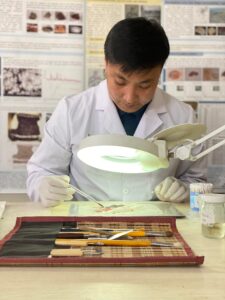Our AFCP project team introductions continue with a Q & A with Conservation Fellow O. Angaragsuren. You can learn more about the AFCP project “Conserving and Preserving Mongolia’s Endangered Textile Traditions and Collections” here.

Kristen Pearson: Could you introduce yourself? Where are you from originally and where are you now?
Odkhuu Angragsuren: my name is Angaragsuren. I was born in Kharkhorin—that was the capital of the Mongol Empire. I was born there and grew up in there. Then, after I graduated from high school, I went to study in Ulaanbaatar.
KP: And how did you first become interested in the field of conservation?
OA: I studied at the Fine Arts Institute of the Mongolian State University of Arts and Culture. I studied Mongolian traditional painting. When I first visited the Fine Art Museum, I saw so many interesting artworks and objects, but their conservation condition was not good. So then I began thinking, why not study conservation as a field? Then, after I finished my bachelor’s degree, I worked at the Kharakhorin museum as the restorator.
KP: can you describe the path you took after that to become a professional conservator? What kind of training you undertook?
OA: During conservation work at the Kharkhorin museum, the KAAK- Commission for the Archaeology of Non-European Cultures, Germany Archaeological Institute organized a practical training program in the LVR Landes museum, Bonn city, Germany. I participated in this training for eight months. The training was focused on objects conservation, for example, metal, ceramic, bone…many kinds of materials. This training gave me foundational conservation skills and introduced me to all kinds of different materials. After that training, I also participated in the ACPCS program (Asia Cooperation Program on Conservation Science) in Korea. This program is organized annually by the National Research Institute for Cultural Heritage of Korea for a group of international participants. During this training, I learned to use analytical instruments to investigate materials for the first time. After that, I understood the importance of analyzing materials before registration and treatment, and I wanted to bring that practice to Mongolian conservation.
KP: After your initial training in conservation, I know you pursued a doctoral degree—where did you study and how did you choose that program?
OA: In 2015 I went to Japan for my PhD. But the story begins a few years before that. In 2011, a huge underground tomb called Shoroon Bumbagar with mural paintings was discovered in Mongolia. Part of my job was copying this painting. Because I had copied it carefully, I knew the original condition of the painting very well. And by 2015, the condition was not good. I really wanted to preserve this painting, so I contacted professor Kohdzuma Yohsei who works at Kyoto University and Nara National Research Institute for Cultural Properties. The Nara National Research Institute for Cultural Properties had experience preserving the mural paintings of Hasugaike Yokoanagun tomb in Miyazaki city, Japan of the same time period as the Shoroon Bumbagar mural tomb in Mongolia. So we decided to work on this project together and I wrote my dissertation on this topic at Kyoto University. My dissertation title was “Conservation of a decorated ancient tomb in harsh climate conditions”.
KP: Can you tell us about some of the other work you did during your PhD?
OA: When I was at the Nara National Research Institute for Cultural Properties I joined several projects. One was the environmental survey at a mural of Hasugaike Yokoanagun tomb in Japan, where the team investigated the materials used in the construction of the mural. Then, when I was working in the kharkhorin museum, I worked on the conservation of some archaeological textiles from the Middle Ages.
KP: How did you first come to learn about textile conservation?
OA: I participated in a textile conservation training in Ulaanbaatar organized by the Goethe Institute. This training gave me the chance to learn a little about textile objects. Then, when I was in Germany, I visited a textile conservation studio and I was able to practice in this studio and handle archaeological textiles for the first time.
KP: What do you think is a strength of archeological conservation or archeology in general in Mongolia today?
OA: Archaeologists in Mongolia have discovered so many interesting, amazing artifacts. Every year we discover so many finds, but these archaeological artifacts are fragile. Mongolia has a harsh climate, and we are located at a high elevation. The environment preserves archaeological materials well, but when archaeologists discover a site and open it, the temperature and humidity quickly changes and the original condition of the object deteriorates. So, our archaeological objects can be especially well preserved, but also especially fragile.
KP: What are you most looking forward to accomplishing through the AFCP project?
OA: Over the last several years, many important textile objects have been discovered in Mongolia. This is the first project focused on the conservation of archaeological textiles specifically. After this project is finished, I hope that Mongolian conservators better understand how to protect and preserve textiles objects and that they understand their importance and value.
KP: I hope so too! To wrap up our chat, what is one fun fact about yourself?
OA: In addition to being a conservator, I’m an artist.
KP: Two questions: What kind of art do you do, and what inspires you as an artist?
OA: I make contemporary paintings, sculptures. As for inspiration, I’m always looking around for interesting artistic challenges in nature or daily life, whether an interesting color, or shape, or pattern.